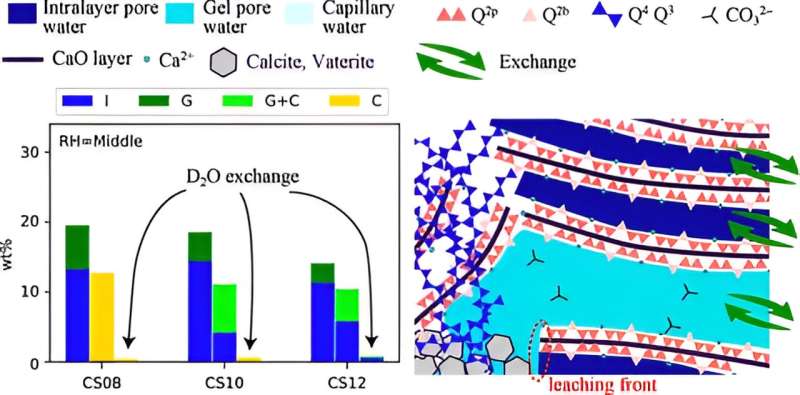This article has been reviewed according to Science X's editorial process and policies. Editors have highlighted the following attributes while ensuring the content's credibility:
fact-checked
peer-reviewed publication
trusted source
proofread
Study sheds light on CO₂ absorption mechanism of cement-based materials

Carbon dioxide (CO2) emissions are currently one of the leading causes of global warming. Cement-based materials have shown promising applications in capturing and solidifying CO2 as minerals through a process called carbonation, offering a potential solution to mitigate the challenges associated with climate change. Consequently, numerous studies have been conducted on the carbonation of cement-based materials to improve the efficiency of carbonation.
Put simply, carbonation in cement paste involves the dissolution of CO2 in water, followed by interaction with calcium silicate hydrates (C–S–H), formed during the hydration of raw materials. During this reaction, the dissolved CO2 forms carbonate ions (CO32-), and further reacts with calcium ions (Ca2+) from C–S–H to create calcium carbonate precipitates. However, despite extensive studies with varying parameters, the complete explanation of carbonation mechanisms is not clearly understood due to the unstable nature of cement paste compounds.
Previous studies have shown that carbonation is strongly impacted by relative humidity (RH), CO2 solubility, calcium/silicate (Ca/Si) ratio, and concentration and saturation level of water in C–S–H. Moreover, it is also important to understand the influence of ions and water transport through the nanometer-sized pores in C–S–H layers, known as gel-pore water.
To answer these questions, Associate Professor Takahiro Ohkubo from the Graduate School of Engineering at Chiba University with his team of researchers, including Taiki Uno from Chiba University, Professor Ippei Maruyama and Naohiko Saeki from The University of Tokyo, Associate Professor Yuya Suda from University of Ryukyus, Atsushi Teramoto from Hiroshima University, and Professor Ryoma Kitagaki from Hokkaido University investigated the mechanism of carbonation reaction under different Ca/Si ratios and RH conditions.
Their study was published in The Journal of Physical Chemistry C on July 8, 2024.
"The role of water transport and carbonation-related structural changes remains an open question. In this study we used a new method to study these factors, using 29Si nuclear magnetic resonance (NMR) and 1H NMR relaxometry, which has been established as an ideal tool for studying water transport in C–S–H," says Associate Professor Ohkubo.
To study the carbonation process, the researchers synthesized C–S–H and subjected them to accelerated carbonation using 100% CO2, far higher than atmospheric levels.
"Natural carbonation in cement materials occurs over several decades by absorbing atmospheric CO2, making it difficult to study in a lab setting. Accelerated carbonation experiments with elevated CO2 concentrations provide a practical solution to this challenge," explains Associate Professor Ohkubo.
The samples were synthesized under varying RH conditions and Ca/Si ratios. Further, they studied the C–S–H samples using 29Si NMR, and the water exchange processes using 1H NMR relaxometry under a deuterium dioxide (D2O) atmosphere.
The researchers found that the structural changes induced by the carbonation reaction, including the collapse of the C–S–H chain structure and changes in the pore size were heavily influenced by the Ca/Si ratio of the C–S–H chain and RH conditions. Additionally, lower RH conditions and a high Ca/Si ratio resulted in smaller-sized pores, suppressing the leaching of Ca2+ ions and water from the interlayer space to gel-pores, leading to inefficient carbonation.
"Our study shows that the carbonation process occurs due to a combination of structural modifications and mass transfer, signifying the importance of studying their interplay, rather than just structural changes," says Associate Professor Ohkubo.
Further highlighting the implications of the present study, Associate Professor Ohkubo adds, "Our findings can contribute to developing new building materials that can absorb large amounts of atmospheric CO2. Additionally, carbonation reactions are also common in organic matter and hence, our new approach will also help to understand the carbonation of compounds in the natural environment."
In conclusion, this study sheds light on the carbonation reaction of cement-based materials, offering a potential solution to CO2 reduction.
More information: Taiki Uno et al, Understanding the Carbonation Phenomenon of C–S–H through Layer Structure Changes and Water Exchange, The Journal of Physical Chemistry C (2024). DOI: 10.1021/acs.jpcc.4c01714
Journal information: Journal of Physical Chemistry C
Provided by Chiba University




















